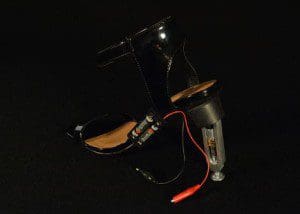
Clothing advertisements have long called for consumers to “try on a new you!” – as though a simple change in wardrobe can unlock previously untapped wells of confidence and charm, leading to a makeover not just of one’s style but of one’s inner self. While this brand of hyperbole is standard in the retail industry, a new range of products from experimental philosopher Jonathon Keats may finally deliver where fashion has failed. Keats’ Superego Suits, which can now be tried on by appointment at Modernism Gallery in San Francisco, are a line of apparel designed to augment—or alter—your personality at will.
Keats, who made headlines last year with his attempts to convince the United Nations to tectonically rearrange the world’s continents in the interest of achieving global harmony, found inspiration for the Superego Suit after reading about recent studies in neuroscience at Harvard and Florida State University and EPFL in Switzerland, including their research into interoception—loosely defined as one’s sense of the physiological condition of their body. “I’m interested in what happens when neuroscience escapes the lab and enters the world,” Keats declares.
To that end, the ever industrious Keats has devised several pieces of apparel designed to put neuroscience’s theories into practice, including Interoceptive Eyewear with irises that open and close in time with the user’s breathing; Ego Boost Bracelets that position the wearer in a testosterone-releasing “power pose” (perfect for the board room); Body Schema Extension Rings which extend the wearer’s reach, therefore increasing their presence in the world; and, perhaps most impressively, Free Will Footwear, battery-based elevator shoes that can adjust the wearer’s height and posture as desired.
Though they’ve yet to be mass-produced, there’s no doubt the Superego Suits arrive in a crowded marketplace. Wearable devices such as the Apple Watch, Google Glass, and Fitbit already allow consumers to alter their daily experience to some degree. Keats isn’t worried. “I don’t see myself as a competitor to Apple,” he readily states. In fact, he remains “absolutely” open to the possibility of building the Superego Suit into already existing platforms such as the Apple Watch. He adds that, while devices like Google Glass are “about augmenting your memory, your knowledge, and your communication, which are profound changes,” they are “arguably still tame compared to the proposition of changing who you believe yourself to be.”

The Superego Suit, could represent a polar shift for the City by the Bay. In recent years, the conversation about San Francisco has turned to criticism of astronomical rent prices and an increasingly ruthless capitalist culture driven by the tech industry. “I absolutely agree that San Francisco is undergoing an identity crisis,” Keats says, adding, “Our relationship with technology has increased to such an extent that this new ecosystem is here and growing and changing the city radically.” One solution? “You might issue Superego Suits to everybody,” he suggests.
A desire for accessibility is precisely why Keats plans to prioritize both affordable pricing and comfort if the Superego Suit is ever mass produced – two concerns that might not immediately come to mind when looking at his somewhat unwieldy prototypes, like the extended metal of the Ego Boost bracelets or the old-fashioned battery apparatus built into the elevator shoes. “Accessibility is going to be key,” Keats acknowledges. To that end, Keats has created Ego Boosters—a device that resembles a balloon that the wearer expands with air and then holds under their arm – and priced them at a consumer-friendly $9.99. The “ego boost” comes from the more confident posture one must assume to keep the balloon-like object placed firmly under their armpit. If the prospect sounds a little uncomfortable, maybe even a little embarrassing, Keats says that’s perfectly alright: “You feel a bit ridiculous,” he admits, then later adds, “I think the awkwardness is important from the standpoint of not making this something that people simply see as a foregone conclusion or as something that they would necessarily want.”
While a mass-produced Superego Suit would more closely resemble the “seamless baubles” and “beautiful objects” designed by Apple, Keats concedes that the sometimes cumbersome, potentially uncomfortable prototype versions are “disruptive” compared to the business-as-usual output of Silicon Valley – and that’s exactly how Keats likes it. The experimental philosopher embraces the “schizophrenic” quality of his creation, particularly the fact the Superego apparel looks beyond functional and glamorous in Elena Dorfman’s fashion photographs yet appears as though it could potentially electrocute the wearer when seen in person, and considers it an essential part of his creation. In part, Keats hopes this cognitive dissonance will cause the observer to re-examine their relationship with technologies that aren’t so awkward, such as the Apple Watch.

“I am not in this project, or any other, undertaking a satire that has some point that I am making and if you just figure out what the point is then we can sweep all this aside,” he continues. At its core, the Superego Suit is designed to “build a more critical relationship with neuroscience.” The apparel line attempts to find a line between the limits of science and humankind’s more existential concerns: if all it takes is an Ego Boost Bracelet to release a chemical that can alter one’s personality on some level, it’s somewhat disquieting to imagine what an entire Superego wardrobe could do – and raises interesting questions about the extent to which we are truly ourselves and not a series of dials and knobs that can be endlessly tweaked by technology.
“The Superego Suit may actually be a way in which to probe the ultimate limits of the degree to which we can remain ourselves as augmented selves,” Keats says, “and also the degree to which what we become as a result of that remains who we philosophically believe ourselves to be—or would want ourselves to be.” Bringing to mind the cyber-punk novels of decades past, he adds, “If it actually all works out then there comes a point where we are going to need to come to terms with being, let’s say, a lot less ‘soulful’ than we would like to believe ourselves to be.”
The Superego Suit arrives at a most auspicious moment. While Keats suggests that the “cyborg revolution” has been occurring ever since our ancestors forged the hand-axe as a tool, there’s no question wearable technologies will only continue to evolve and augment what we commonly think of a “self” in the years to come. Keats’ Superego Suit offers a glimpse into a possible future—a prototype for the sleek, market-ready devices to come. Growing reflective, Keats adds, “I think we need to take science in hand and do the science ourselves in order to be a part of the exploratory process of discovery, and figure out the extent to which we really are reducible to some of the terms that are posited by neuroscience. Or if not, what those added variables are and how to integrate them into the science of the future.”
